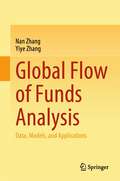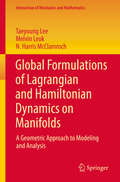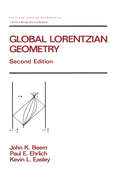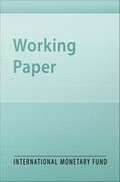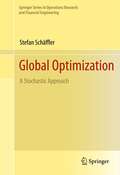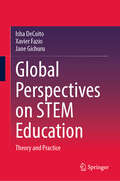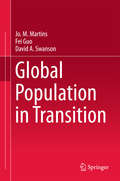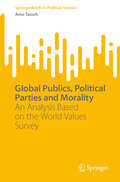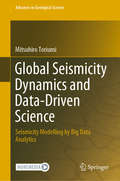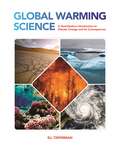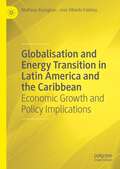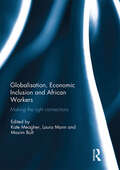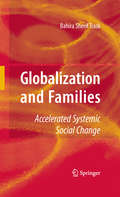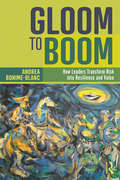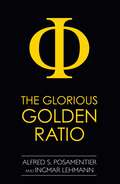- Table View
- List View
Global Flow of Funds Analysis: Data, Models, and Applications
by Nan Zhang Yiye ZhangThis book is the first to focus on the global flow of funds (GFF), providing an introduction to its fundamental concepts and establishing a theoretical framework for analysis. It connects the flow of funds within domestic economies to that of the rest of the world, offering a comprehensive analysis of GFF dynamics. This study enhances GFF statistics, enabling the assessment of global financial stability from both national and cross-border sectoral perspectives. The GFF data provide valuable insights into analyzing interconnectivity across borders and an understanding of global financial interdependencies. By examining the data sources and reconstructing the statistical framework to establish the GFF statistical matrix, this book conducts a case study to evaluate financial risks and influences in G20 countries. Subsequently, it connects the GFF matrix with sectoral account data and the flow of funds to establish the sectoral from-whom-to-whom financial stock matrix (SFSM). The SFSM aims to establish a new framework for conducting multi-country, multi-sector analysis within the G20, with a special emphasis on examining the national and cross-border exposures of sectors in China, Japan, and the USA. This involves constructing country-specific financial networks and connecting them based on cross-border exposures. The systematic analysis results effectively showcase the financial interconnections among G20 countries within the GFF and shed light on the attributes of external shocks and internal influences. The focus is particularly on the changes in risk exposure between China and the USA concerning their external assets and liabilities and the implications of economic decoupling of these dynamics.
Global Formulations of Lagrangian and Hamiltonian Dynamics on Manifolds
by N. Harris Mcclamroch Taeyoung Lee Melvin LeokThis book provides an accessible introduction to the variational formulation of Lagrangian and Hamiltonian mechanics, with a novel emphasis on global descriptions of the dynamics, which is a significant conceptual departure from more traditional approaches based on the use of local coordinates on the configuration manifold. In particular, we introduce a general methodology for obtaining globally valid equations of motion on configuration manifolds that are Lie groups, homogeneous spaces, and embedded manifolds, thereby avoiding the difficulties associated with coordinate singularities. The material is presented in an approachable fashion by considering concrete configuration manifolds of increasing complexity, which then motivates and naturally leads to the more general formulation that follows. Understanding of the material is enhanced by numerous in-depth examples throughout the book, culminating in non-trivial applications involving multi-body systems. This book is written for a general audience of mathematicians, engineers, and physicists with a basic knowledge of mechanics. Some basic background in differential geometry is helpful, but not essential, as the relevant concepts are introduced in the book, thereby making the material accessible to a broad audience, and suitable for either self-study or as the basis for a graduate course in applied mathematics, engineering, or physics.
Global Logarithmic Deformation Theory (Lecture Notes in Mathematics #2373)
by Simon FeltenThis monograph provides the first systematic treatment of the logarithmic Bogomolov-Tian-Todorov theorem. Providing a new perspective on classical results, this theorem guarantees that logarithmic Calabi-Yau spaces have unobstructed deformations. Part I develops the deformation theory of curved Batalin-Vilkovisky calculi and the abstract unobstructedness theorems which hold in quasi-perfect curved Batalin-Vilkovisky calculi. Part II presents background material on logarithmic geometry, families of singular log schemes, and toroidal crossing spaces. Part III establishes the connection between the geometric deformation theory of log schemes and the purely algebraic deformation theory of curved Batalin-Vilkovisky calculi. The last Part IV explores applications to the Gross-Siebert program, to deformation problems of log smooth and log toroidal log Calabi-Yau spaces, as well as to deformations of line bundles and deformations of log Fano spaces. Along the way, a comprehensive introduction to the logarithmic geometry used in the Gross-Siebert program is given. This monograph will be useful for graduate students and researchers working in algebraic and complex geometry, in particular in the study of deformation theory, degenerations, moduli spaces, and mirror symmetry.
Global Lorentzian Geometry (Chapman & Hall/CRC Pure and Applied Mathematics #202)
by John K. BeemBridging the gap between modern differential geometry and the mathematical physics of general relativity, this text, in its second edition, includes new and expanded material on topics such as the instability of both geodesic completeness and geodesic incompleteness for general space-times, geodesic connectibility, the generic condition, the sectional curvature function in a neighbourhood of degenerate two-plane, and proof of the Lorentzian Splitting Theorem.;Five or more copies may be ordered by college or university stores at a special student price, available on request.
Global Market Conditions and Systemic Risk
by Brenda González-Hermosillo Heiko HesseA report from the International Monetary Fund.
Global Migrants, Local Culture
by Laura TabiliEmploying the first analysis of the entire population of any British town, this book examines how overseas migrants affected society and culture in South Shields near Newcastle-upon-Tyne. Resituating Britain within global processes of migration and cultural change, it recasts British society pre-1940 as culturally and racially dynamic and diverse.
Global Optimization
by Stefan SchäfflerThis self-contained monograph presents a new stochastic approach to global optimization problems arising in a variety of disciplines including mathematics, operations research, engineering, and economics. The volume deals with constrained and unconstrained problems and puts a special emphasis on large scale problems. It also introduces a new unified concept for unconstrained, constrained, vector, and stochastic global optimization problems. All methods presented are illustrated by various examples. Practical numerical algorithms are given and analyzed in detail. The topics presented include the randomized curve of steepest descent, the randomized curve of dominated points, the semi-implicit Euler method, the penalty approach, and active set strategies. The optimal decoding of block codes in digital communications is worked out as a case study and shows the potential and high practical relevance of this new approach. Global Optimization: A Stochastic Approach is an elegant account of a refined theory, suitable for researchers and graduate students interested in global optimization and its applications.
Global Optimization Methods In Geophysical Inversion
by Mrinal K. Sen Paul L. StoffaOne of the major goals of geophysical inversion is to find earth models that explain the geophysical observations. Thus the branch of mathematics known as optimization has found significant use in many geophysical applications. Both local and global optimization methods are used in the estimation of material properties from geophysical data. As the title of the book suggests, the aim of this book is to describe the application of several recently developed global optimization methods to geophysical problems. bull; The well known linear and gradient based optimization methods have been summarized in order to explain their advantages and limitationsbull; The theory of simulated annealing and genetic algorithms have been described in sufficient detail for the readers to understand the underlying fundamental principles upon which these algorithms are basedbull; The algorithms have been described using simple flow charts (the algorithms are general and can be applied to a wide variety of problemsStudents, researchers and practitioners will be able to design practical algorithms to solve their specific geophysical inversion problems. The book is virtually self-contained so that there are no prerequisites, except for a fundamental mathematical background that includes a basic understanding of linear algebra and calculus.
Global Perspectives for Local Action: Using TIMSS to Improve U.S. Mathematics and Science Education
by National Research CouncilThe Third International Mathematics and Science Study (TIMSS) raised the alarm about U.S. mathematics and science education. Most Americans are now aware that U.S. students lag behind their peers in other developed nations. In one state, the legislature reacted by lengthening the school year, assuming that more time on academic content would boost student performance. Some educators have fixed the blame on the mathematics and science curricula typically used in U.S. schools.Does the problem lie in the curricula, instruction, or the system of support available to teachers? This book presents the first comprehensive analysis of TIMSS study--a half-million students from 15,000 schools around the world. It presents detailed reports on three major aspects of education, including curriculum issues, teaching practices, and school support.
Global Perspectives on Children's Health Literacy: Intersections Between Health, Education and Community
by Rosie Nash Vaughan Cruickshank Shandell ElmerThis book examines global perspectives of health literacy development to explore the intersections between health, education, and community settings. International health literacy experts provide a collection of important insights and recommendations that are urgently required to inform practice and policy. The impetus for this book is a growing recognition that a siloed approach to supporting health and health literacy exists in many countries. This book addresses a gap in the international literature by presenting solutions that promote ongoing collaboration across settings to redress inequity and optimize global health. Identifying intersections between the settings is critically important to supporting these collaborations. Health literacy is the ability to find, use, evaluate and apply information to look after our health. Developing the personal asset of health literacy earlier in life influences adult health behaviours. A Health in All Policies approach has been globally endorsed; however, a health literacy in all settings approach is yet to be realised. As a social determinant of health, health literacy can determine health outcomes, educational attainment, social equity, and productivity. The authors investigate the health literacy development of children and their communities within particular regions, exploring whether health literacy is addressed as a health, education or community issue. They describe where silos exist between and within settings, aiming to highlight areas where health literacy is present. This helps identify challenges and opportunities for optimizing health literacy development. Global Perspectives on Children's Health Literacy is essential reading for public health and health promotion researchers and practitioners, primordial prevention researchers, policy makers, health and education ministers, community service ministers, youth organisations, librarians, school teachers, health and physical education teachers, school nurses, child and parenting services nurses, paediatricians, and allied health professionals who work with children and families (e.g., social workers, speech pathologists, dietitians).
Global Perspectives on STEM Education: Theory and Practice
by Isha DeCoito Xavier Fazio Jane GichuruThis book focuses on STEM education as it applies to global competencies, innovative curriculum and accompanying pedagogy. Through a thematic approach, the authors explore cross-cutting perspectives, with a focus on social, equitable, environmental, and scientific issues as they relate to STEM literacy. The research outlined in the book adopts an integrated STEM framework that assesses, analyzes and explicitly links all STEM disciplines. The book prepares and inspires both educators and students to participate in STEM on a global level. The research presented in the book highlights innovative and unique classroom practices in STEM education (e.g., STEM environmental projects, digital video games). The book links research on and in practice, and the intended audience include STEM educators, researchers, curriculum developers, and policymakers interested in innovative STEM education.
Global Perspectives on Social Capital and Health
by Ichiro Kawachi S. V. Subramanian Soshi TakaoThis book is a follow up to Social Capital and Health (2008), edited by Kawachi, Subramanian & Kim. Global Perspectives on Social Capital and Health provides a timely update on emerging topics in a fast-growing field, and features contributions from an outstanding international team of scholars, selected from a diverse range of disciplinary backgrounds including: social epidemiology, medical geography, social psychology, social welfare and gerontology, pediatrics, political science, economics, and medical sociology. The book is organized in three parts: Part 1. Emerging directions in social capital research. This section highlights novel directions in social capital research. These include: a) novel settings for conducting research on social capital (workplaces, schools), b) new approaches for causal inference in social capital (instrumental variable analysis, twin fixed effects designs); c) cutting-edge directions for social capital research, including studies of the origins of community social capital, the use of social network analysis to investigate social capital, and novel methods for investigating the link between social capital and crime. Part 2. Social capital and health policy. The three chapters in this section highlight implications of social capital for interventions and health policy. Part 3. Social capital and health in global perspective The four chapters in this section look at research on social capital and health from a global perspective. The authors summarize the empirical studies on social capital and health conducted in each country/region, or each population group; discuss how the concept of social capital "translates" across different cultures; and identify challenges and future directions for research.
Global Population in Transition
by David A. Swanson Jo. M. Martins Fei GuoThis book deals with macro and micro aspects of population change and their inter-face with socio-economic factors and impact. It examines theoretical notions and pursues their empirical manifestations and uses multidisciplinary approaches to population change and diversity. It investigates the organic nature of the relationships between socio-economic factors and population change and the feedback loops that affect socio-economic organisation and behaviour. The book brings together material often scattered in a number of sources and disciplines that helps to understand population change and their socio-economic aspects. In addition to dealing with the more conventional factors in population dynamics in the form of fertility, mortality and migration, the book examines socio-economic forces that influence them. It discusses population evolving attributes that affect population characteristics and social and behaviour and impact on the environment. Further, it deals with social organisation and pathways that lead to different social and economic development and standards of living of diverse populations.
Global Population: History, Geopolitics, and Life on Earth
by Alison BashfordConcern about the size of the world's population did not begin with the "population bomb" in 1968. It arose in the aftermath of World War I and was understood as an issue with far-reaching ecological, agricultural, economic, and geopolitical consequences. The world population problem concerned the fertility of soil as much as the fertility of women, always involving both "earth" and "life." Global Population traces the idea of a world population problem as it evolved from the 1920s through the 1960s. The growth and distribution of the human population over the planet's surface came deeply to shape the characterization of "civilizations" with different standards of living. It forged the very ideas of development, demographically defined three worlds, and, for some, an aspirational "one world." Drawing on international conference transcripts and personal and organizational archives, this book reconstructs the twentieth-century population problem in terms of migration, colonial expansion, globalization, and world food plans. Population was a problem in which international relations and intimate relations were one. Global Population ultimately shows how a geopolitical problem about sovereignty over land morphed into a biopolitical solution, entailing sovereignty over one's person.
Global Population: History, Geopolitics, and Life on Earth (Columbia Studies in International and Global History)
by Alison BashfordConcern about the size of the world's population did not begin with the "population bomb" in 1968. It arose in the aftermath of World War I and was understood as an issue with far-reaching ecological, agricultural, economic, and geopolitical consequences. The world population problem concerned the fertility of soil as much as the fertility of women, always involving both "earth" and "life."Global Population traces the idea of a world population problem as it evolved from the 1920s through the 1960s. The growth and distribution of the human population over the planet's surface came deeply to shape the characterization of "civilizations" with different standards of living. It forged the very ideas of development, demographically defined three worlds, and, for some, an aspirational "one world."Drawing on international conference transcripts and personal and organizational archives, this book reconstructs the twentieth-century population problem in terms of migration, colonial expansion, globalization, and world food plans. Population was a problem in which international relations and intimate relations were one. Global Population ultimately shows how a geopolitical problem about sovereignty over land morphed into a biopolitical solution, entailing sovereignty over one's person.
Global Publics, Political Parties and Morality: An Analysis Based on the World Values Survey (SpringerBriefs in Political Science)
by Arno TauschThis book provides a groundbreaking empirical study on the persistence of religious morality in an increasingly secular world. Analyzing data from the 2019–2022 World Values Survey and European Values Survey, it examines religious adherence and morality across 82 countries and over 400 political parties. Using advanced index methodologies, the study reveals where and how religious norms, particularly those rooted in the Ten Commandments, continue to shape social values and how this affects political party support. Essential for scholars, policymakers, and religious communities, this book challenges the notion that secularization is inevitable and explores the complex relationship between faith, politics, and global development. &“In this book, Arno Tausch, a political scientist associated with the University of the Free State in South Africa, impressively demonstrates that the Western political left would be well advised to return to the fundamental values of social democracy that are open to world religions, as set out by Karl Polanyi, rather than following the ideas of Michel Foucault and Judith Butler. From the perspective of the Global South, he radically reveals how the Western world is moving away from the ethical imperatives of world religions. This is a disturbing yet highly topical issue, as evidenced by the recent elections in America.&”Werner J. Patzelt, Professor Emeritus of Political Systems and Comparative Politics, TU Dresden / MCC Brussels, Visiting Professor of Research &“Incisive and erudite, Arno Tausch&’s latest offering Global Publics, Political Parties and Morality: An analysis based on the World Values Survey is a magnificent account of the state of the politicisation of faith in different contexts. Theoretically anchored and empirically rich, this book is a must for those seeking to grapple with the place of religion in our fragile polities&”.Professor Hussein Solomon, Centre for Gender and Africa Studies, University of the Free State, South Africa
Global Seismicity Dynamics and Data-Driven Science: Seismicity Modelling by Big Data Analytics (Advances in Geological Science)
by Mitsuhiro ToriumiThe recent explosion of global and regional seismicity data in the world requires new methods of investigation of microseismicity and development of their modelling to understand the nature of whole earth mechanics. In this book, the author proposes a powerful tool to reveal the characteristic features of global and regional microseismicity big data accumulated in the databases of the world. The method proposed in this monograph is based on (1) transformation of stored big data to seismicity density data archives, (2) linear transformation of microseismicity density data matrixes to correlated seismicity matrixes by means of the singular value decomposition method, (3) time series analyses of globally and regionally correlated seismicity rates, and (4) the minimal non-linear equations approximation of their correlated seismicity rate dynamics. Minimal non-linear modelling is the manifestation for strongly correlated seismicity time series controlled by Langevin-type stochastic dynamic equations involving deterministic terms and random Gaussian noises. A deterministic term is composed minimally with correlated seismicity rate vectors of a linear term and of a term with a third exponent. Thus, the dynamics of correlated seismicity in the world contains linearly changing stable nodes and rapid transitions between them with transient states. This book contains discussions of future possibilities of stochastic extrapolations of global and regional seismicity in order to reduce earthquake disasters worldwide. The dataset files are available online and can be downloaded at springer.com.
Global University Rankings: Challenges for European Higher Education
by Tero ErkkiläGlobal University Rankings explores the novel topic of global university rankings and their effects on higher education in Europe. The contributions in this volume outline different discourses on global university rankings and explore the related changes concerning European higher education policies, disciplinary traditions and higher education institutions. The first global university rankings were published less than a decade ago, but these policy instruments have become highly influential in shaping the approaches and institutional realities of higher education. The rankings have portrayed European academic institutions in a varying light. There is intense reflexivity over the figures, leading to ideational changes and institutional adaptation that take surprisingly similar forms in different European countries. The contributions in this book critically assess global university rankings as a policy discourse that would seem to be instrumental to higher education reform throughout Europe.
Global Warming Science: A Quantitative Introduction to Climate Change and Its Consequences
by Eli TzipermanA quantitative, broad, hands-on introduction to the cutting-edge science of global warmingThis textbook introduces undergraduates to the concepts and methods of global warming science, covering topics that they encounter in the news, ranging from the greenhouse effect and warming to ocean acidification, hurricanes, extreme precipitation, droughts, heat waves, forest fires, the cryosphere, and more. This book explains each of the issues based on basic statistical analysis, simple ordinary differential equations, or elementary chemical reactions. Each chapter explains the mechanisms behind an observed or anticipated change in the climate system and demonstrates the tools used to understand and predict them. Proven in the classroom, Global Warming Science also includes “workshops” with every chapter, each based on a Jupyter Python notebook and an accompanying small data set, with supplementary online materials and slides for instructors. The workshop can be used as an interactive learning element in class and as a homework assignment.Provides a clear, broad, quantitative yet accessible approach to the science of global warmingEngages students in the analysis of climate data and models, examining predictions, and dealing with uncertaintyFeatures workshops with each chapter that enhance learning through hands-on engagementComes with supplementary online slides, code, and data filesRequires only elementary undergraduate-level calculus and basic statistics; no prior coursework in science is assumedSolutions manual available (only to instructors)
Globaler Katholizismus, Toleranz und die offene Gesellschaft: Eine empirische Studie über die Wertesysteme der Katholiken
by Arno Tausch Stanislaw ObirekDieses Buch bewertet systematisch die politischen und sozialen Werte der mehr als 1,3 Milliarden Katholiken auf der ganzen Welt, der bei weitem größten Konfession des westlichen Christentums. Auf der Grundlage einer umfassenden Analyse von Daten aus dem World Values Survey und anderen globalen Meinungsumfragen wirft das Buch ein neues Licht auf die Wertesysteme und Meinungen der Katholiken. Die Autoren heben zentrale Probleme und Herausforderungen hervor, mit denen die Kirche derzeit bei der Anpassung an die moderne Welt konfrontiert ist, einschließlich des katholischen Antisemitismus, der religiösen und sexuellen Toleranz und der Meinungen zur Demokratie, und bieten gleichzeitig eine anthropologische Reflexion darüber, wie gut sich die Kirche an die Anforderungen einer offenen Gesellschaft anpasst oder nicht.
Globalisation and Energy Transition in Latin America and the Caribbean: Economic Growth and Policy Implications
by Matheus Koengkan José Alberto FuinhasThis book explores the potential for renewable energy development and the adoption of sustainable production processes in Latin America and the Caribbean. By examining the energy transition process, the impact of environmental degradation, and the relationship between renewable energy sources and economic growth, the effects of increased globalisation and liberalisation in this part of the world are analysed. Particular attention is given to renewable energy investment, the energy-economics growth nexus, the impact of trade openness, and the mitigation of carbon emissions. This book aims to highlight econometric techniques that can be used to tackle issues relating to globalisation, the energy transition, and environmental degradation. It will be relevant to researchers and policymakers interested in energy and environmental economics.
Globalisation, Economic Inclusion and African Workers: Making the Right Connections
by Maxim Bolt Kate Meagher Laura MannThis book addresses the question of whether greater inclusion in the global economy offers a solution to rising unemployment and poverty in contemporary Africa. The authors trace the connection between global demographic change and new mechanisms of economic inclusion via global value chains, digital networks, labour migration, and corporate engagement with the bottom of the pyramid, challenging the claim that African workers have become functionally irrelevant to the global economy. They expose the shift of global demand for African workers from formal to increasingly informalised labour arrangements, mediated by social enterprises, labour brokers, graduate entrepreneurs and grassroots associations. Focusing on global employment connections initiated from above and from below, the authors examine whether global labour linkages increase or reduce problems of vulnerable and unstable working conditions within African countries, and considers the economic and political conditions needed for African workers to capture the gains of inclusion in the global economy. This book was previously published as a special issue of the Journal of Development Studies.
Globalization and Families
by Bahira TraskAs our world becomes increasingly interconnected through economic integration, technology, communication, and political transformation, the sphere of the family is a fundamental arena where globalizing processes become realized. For most individuals, family in whatever configuration, still remains the primary arrangement that meets certain social, emotional, and economic needs. It is within families that decisions about work, care, movement, and identity are negotiated, contested, and resolved. Globalization has profound implications for how families assess the choices and challenges that accompany this process. Families are integrated into the global economy through formal and informal work, through production and consumption, and through their relationship with nation-states. Moreover, ever growing communication and information technologies allow families and individuals to have access to others in an unprecedented manner. These relationships are accompanied by new conceptualizations of appropriate lifestyles, identities, and ideologies even among those who may never be able to access them. Despite a general acknowledgement of the complexities and social significance inherent in globalization, most analyses remain top-down, focused on the global economy, corporate strategies, and political streams. This limited perspective on globalization has had profound implications for understanding social life. The impact of globalization on gender ideologies, work-family relationships, conceptualizations of children, youth, and the elderly have been virtually absent in mainstream approaches, creating false impressions that dichotomize globalization as a separate process from the social order. Moreover, most approaches to globalization and social phenomena emphasize the Western experience. These inaccurate assumptions have profound implications for families, and for the globalization process itself. In order to create and implement programs and policies that can harness globalization for the good of mankind, and that could reverse some of the deleterious effects that have affected the world's most vulnerable populations, we need to make the interplay between globalization and families a primary focus.
Gloom to Boom: How Leaders Transform Risk into Resilience and Value
by Andrea Bonime-BlancLeaders – whether in business, government or the nonprofit sector – take risks but often without fully understanding risk at a strategic level. Expanding upon the well-known "ESG" risks, this book explains the key nonfinancial (environmental, social, governance and technological or ESGT) risks. For many leaders (including board members), taking risk without knowledge or preparation can lead to organizational crisis, scandal and value destruction. For those who are prepared, resilience follows and so does the ability to transform ESGT risk into opportunity and value for stakeholders. In this book, global governance, risk, ethics and cyber strategist, author and board member, Andrea Bonime-Blanc, shows practitioners at all levels how to effectively identify and manage their top ESGT risks to avoid crises and transform risk into sustainable long-term resilience and value. Gloom to Boom is a book for everyone – from the highest levels of leadership in an organization (the board, CEO and C-suite), to other senior leaders (the chief risk officer, CFO, general counsel, head of CSR and sustainability, CISO, CHRO), and midlevel leaders, students and folks simply interested in current affairs and the role and impact of strategic risk and opportunity on their lives.
Glorious Golden Ratio
by Alfred S. Posamentier Ingmar LehmannWhat exactly is the Golden Ratio? How was it discovered? Where is it found? These questions and more are thoroughly explained in this engaging tour of one of mathematics' most interesting phenomena. The authors trace the appearance of the Golden Ratio throughout history, demonstrate a variety of ingenious techniques used to construct it, and illustrate the many surprising geometric figures in which the Golden Ratio is embedded. Requiring no more than an elementary knowledge of geometry and algebra, the authors give readers a new appreciation of the indispensable qualities and inherent beauty of mathematics.
